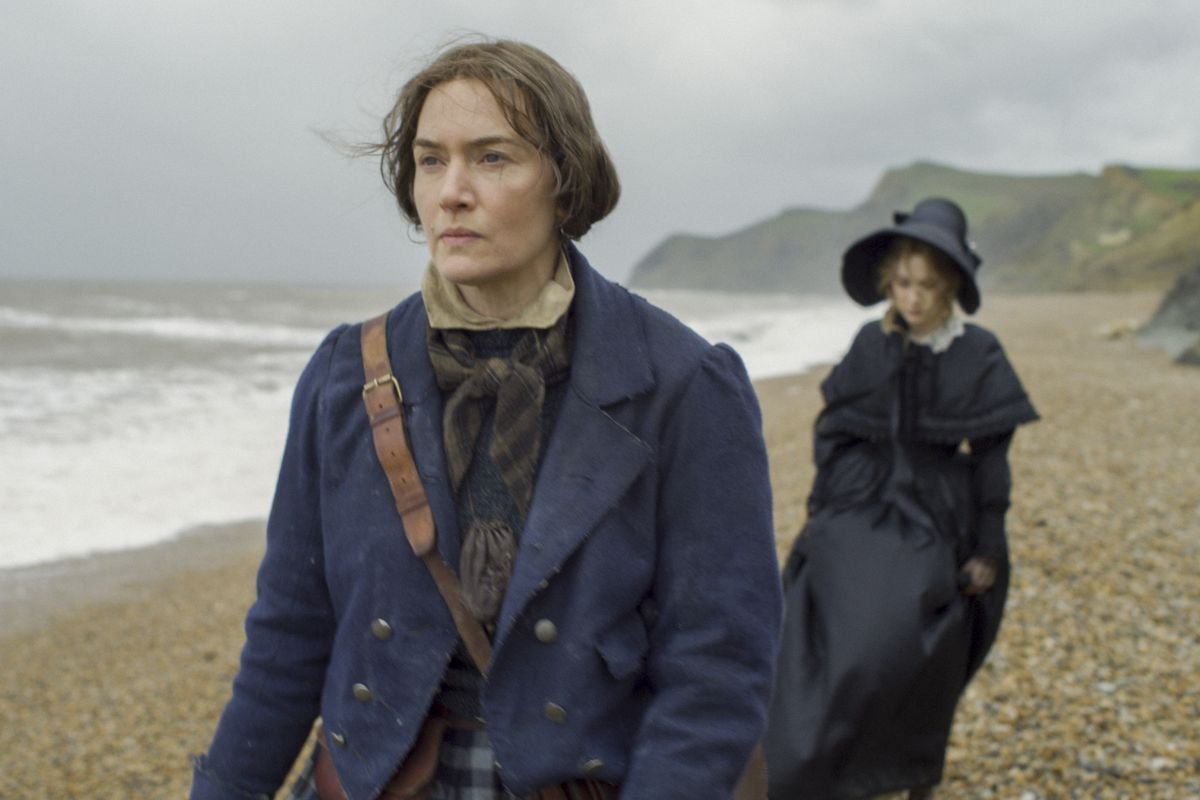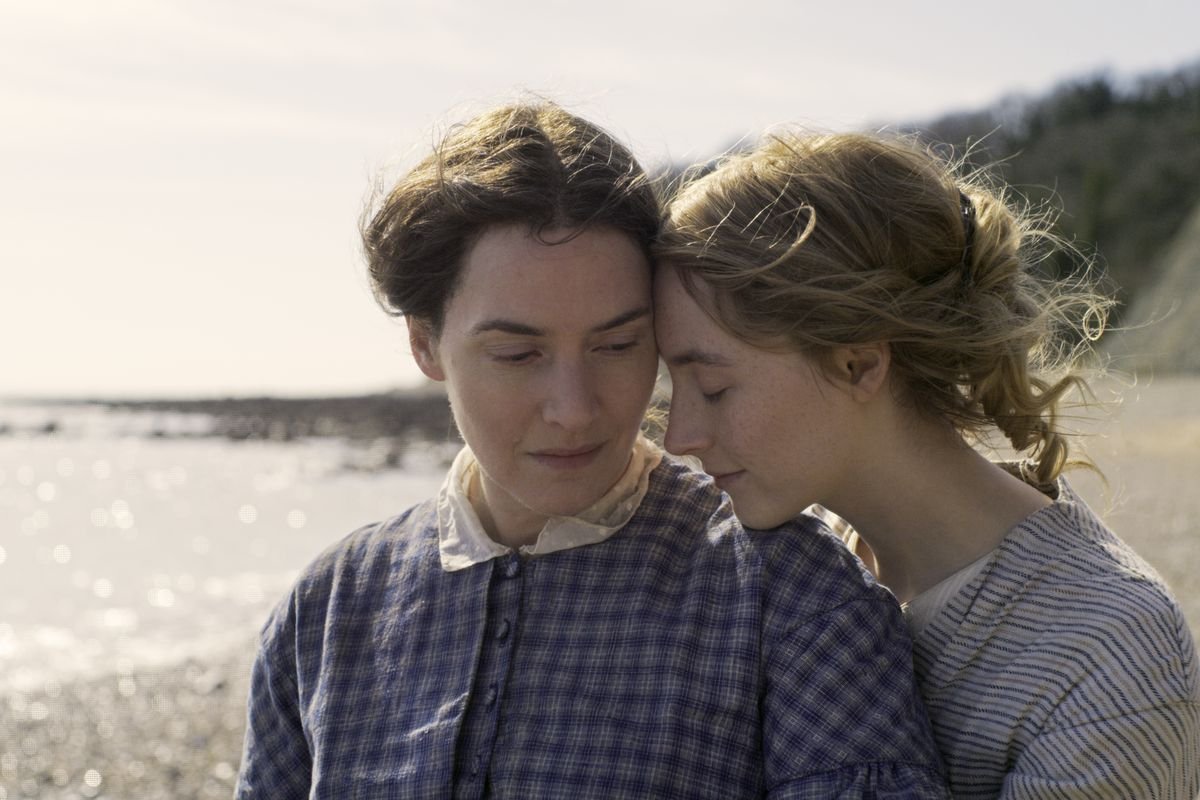Loosely based on the later life of paleontologist Mary Anning (1799-1847), Francis Lee’s queer romance movie Ammonite is a clinical but intriguing excavation of historical fact. The film reworks several of Anning’s relationships that are only known to the public through her correspondence, and along the way, it both infers and invents a romantic chronology where one may or may not have existed. Whether strictly factual or broadly truthful in a poetic sense, its approach to queer history as coded, long-buried document is its most exacting facet. But as a story of science, hidden desire, and sparks re-igniting the soul, it’s a languid affair.
Kate Winslet plays Anning with a weary resolve that appears to mask a lurking loneliness, much like in the only known portrait of Anning. In fact, much of the film’s design feels like it was extrapolated from this single visual reference. The costumes, especially Anning’s, have the same subdued blue hues, while the Dorset beach she frequents is littered with severely muted earth tones, like the painting’s backdrop. All the elements are conceived and captured in a way that feels fittingly depressing. This version of Anning appears to lead a solitary life, except for her brief interactions with her aging mother (Gemma Jones), with whom she shares a home and seaside shop.
When an admirer of Anning’s, Londoner Roderick Murchison (James McArdle), asks to shadow her on an excavation, she seems none too pleased, even though he offers to pay her. She has her own process of selecting rocks and other geological samples, and a keen eye for noticing when they might be hiding something of value or significance — a skill that doesn’t translate to her approach to people. She takes little notice of Roderick’s invalid wife Charlotte (Saoirse Ronan) when she accompanies him to the shop, and she seems unenthused when her mother and Roderick convince her to become Charlotte’s paid companion. Anning is a fossil of sorts, trapped in a moment in time. She hides work pants and hefty boots beneath her flowing dress, but these are just the facts of her existence — occupational norms rather than a sign she’s trying to subvert her role in society. She’s long since accepted her place within (or rather, outside of) her male-dominated field.

Photo: Neon
Charlotte, meanwhile, feels trapped by the circumstances of her marriage, and an implied miscarriage as well. Roderick isn’t outright callous, but he’s careless enough with her feelings that she retreats inward. She cocoons herself within a shell of mourning, and doesn’t emerge until Anning is forced to show her compassion when she becomes ill. So begins Anning and Charlotte’s friendship, en route to their secret affair, though it takes inordinately long for any passion or tension to break through Ammonite’s frigid veneer. Even when it does, the moments where romance manifest through any change in mood or visual tone are vanishingly rare.
There’s one exception early on, when Anning visits an old friend, Elizabeth Philpot (Fiona Shaw) to buy medicine for Charlotte. From the moment Anning enters Philpot’s garden, the lush greenery and warm rays of sunlight reflecting off her face make it amply clear that she’s entering a space of memory and passion. The scene bursts with life and colour, even though it’s brief; the film seems to imply that Anning and Philpot were once involved, though Lee never states that outright. Instead, he relies on visual craft and hisits actors’ restrained body language to create a sense of subdued longing. By contrast, the film’s central relationship — between Anning and Charlotte, two women seeking physical and spiritual liberation — isn’t remotely as affecting, even once Charlotte recovers and finds a new lease on life, and Anning begins to look past the boundaries of her rote existence.
The film is certainly at a disadvantage thanks to the long shadow cast by Céline Sciamma’s sublime beachside period romance Portrait of a Lady on Fire, which is set seven decades earlier, but has striking plot similarities to Lee’s historical fiction. Ammonite is plain and serviceable, but not without merit. Though this sounds like a backhanded compliment, it would make for pleasant, unobtrusive airplane viewing. (At just a hair under two hours, it would certainly be easy to schedule.) Where the soundscape in Portrait of a Lady on Fire alternates between symphonies and haunting silences, and its emotional journey follows suit, Ammonite has a more constant hum, whether it’s background chatter at night-time soirées or the cacophony of the tides. It’s cinematic white noise, both in a literal, auditory sense, and in the way its story unfolds: mechanically and unsurprisingly.
Each shot seems to last for the exact amount of time it takes to absorb visual information, but not long enough to draw the audience into any emotional mysteries. It’s exactly the kind of film viewers can switch off their brains to watch, though enjoying it might also demand closing off their hearts. Each moment feels fragmented and isolated, like a staged vignette rather than part of a scene or larger story. This visual isolation compliments the characters at first, though it clashes wildly with the moments when they’re meant to break out of their molds and find meaning in each other.
Possibly the film shouldn’t have focused so heavily on Anning’s romantic entanglements. At least on paper, it would be cruel to suggest that people should be robbed of the rare queer romance where characters use compassion to rescue each other from the brink of hopelessness. But in the process of inventing this fiction, Lee centers it above all else, and seems to forego other vital attributes of Anning’s life story, regardless of the larger conversation he brings to the table.

Photo: Neon
No one knows the details of Anning’s personal exploits, though as with a great many historical figures, the numerous documented references of close friendships with other women, along with far fewer references to heterosexual romance, suggest it isn’t a stretch to read between the lines. Ammonite is, after all, not pretending to be anything but an artistic interpretation of history, one which subtly pushes back against the hairbrained idea that queerness is somehow modern or novel. But what’s lost in the process — and needn’t have been, even in a romantic tale — is Anning’s significance as an actual significant historical figure. (Not to mention that she may have been the inspiration for the tongue-twister “She sells seashells on the seashore.”) It’s ironic that Anning’s place as a trailblazing woman scientist is so ignored in a film named after the many spiral fossils she discovered.
By sidelining Anning’s actual work, and treating it as a chore instead of an ongoing passion, Lee also forgoes any intellectual curiosity he might have afforded her. Winslet works wonders with what she’s given, as she’s often wont to do. But while she finds occasional moments of agony in the character, her version of Anning never has the opportunity to feel like a complete human being, with a unique perspective on nature and what it means to be alive. Anning or Charlotte barely exist outside the path laid out for them by the plot; there’s no risk or possibility involved in their romance, even though the circumstances so easily lend themselves to danger and dreams. The only time tension arises is when they try to keep their lovemaking quiet, so Anning’s mother won’t overhear them. But their romance never clashes with the outside world — they barely acknowledge the world exists — and neither character exhibits anything resembling want or desire beyond the immediate moment, until the film’s concluding scenes.
Regardless of what story Lee and his team set out to tell, this is a film where romance settles into the unremarkable and ordinary. Anning and Charlotte’s hands get dirty, but they wash them before touching each other. They engage in forbidden passions without reveling in the forbidden. They don’t even seem to have much fun. It’s all a bit too sanitized, in spite of the copious nudity and oral sex.
In telling this particular story in this particular way, Ammonite sets up expectations that no one realistically had of a Mary Anning biopic — and then fails to meet them. It’s inoffensive, and a lethargic rhythm is still a rhythm at the end of the day. But the most drama the film is ever likely to accomplish is unseating some more deserving but less prestigious-looking contender come award season 2021.
Ammonite is available for premium digital rental on Amazon and Google Play.
















































